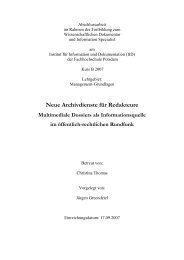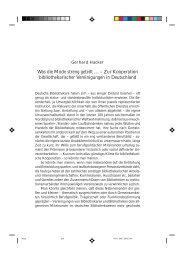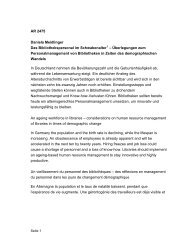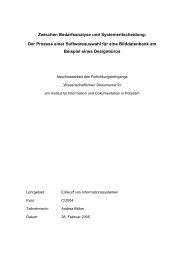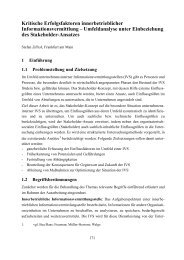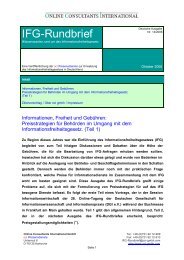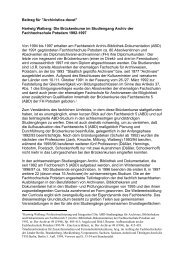PDF(886K) - Wiley Online Library
PDF(886K) - Wiley Online Library
PDF(886K) - Wiley Online Library
You also want an ePaper? Increase the reach of your titles
YUMPU automatically turns print PDFs into web optimized ePapers that Google loves.
means to knowledge exploration]. Information – Wissenschaft und Praxis,<br />
61(1), 5–18.<br />
Gödert, W. (2010b). Semantische Wissensrepräsentation und Interoperabilität.<br />
Teil 2: Ein formales Modell semantischer Interoperabilität [Semantic<br />
knowledge representation and interoperability. Part 2: A formal model of<br />
semantic interoperability]. Information – Wissenschaft und Praxis, 61(1),<br />
19–28.<br />
Gust von Loh., S., Stock, M., & Stock, W.G. (2009, November). Knowledge<br />
organization systems and bibliographical records in the state of flux.<br />
Hermeneutical foundations of organizational information culture. Paper<br />
presented at the Annual Meeting of the American Society for Information<br />
Science and Technology (ASIS& T 2009), Vancouver, Canada.<br />
Habermas, J. (1987). Knowledge and human interest. Cambridge, United<br />
Kingdom: Polity Press. (First published 1968).<br />
Habermas, J. (1998). Between facts and norms. Cambridge, MA: MIT Press.<br />
Habermas, J. (2006). Political communication in media society. Does democracy<br />
still enjoy an epistemic dimension? The impact of normative theory<br />
on empirical research. Communication Theory, 16, 411–426.<br />
Heidegger, M. (1962). Being and time. San Francisco: Harper. (First<br />
published 1927).<br />
Hjørland, B. (2007). Semantics and knowledge organization.Annual Review<br />
of Information Science and Technology, 41, 367–406.<br />
Hjørland, B. (2009). Concept theory. Journal of the American Society for<br />
Information Science and Technology, 60(8), 1519–1536.<br />
Hjørland, B. (2010a). Concepts. Classes and colligation. Bulletin of the<br />
American Society for Information Science and Technology, 36(3), 2–3.<br />
Hjørland, B. (2010b).Answer to Professor Szostak (concept theory). Journal<br />
of the American Society for Information Science and Technology, 61(5),<br />
1078–1080.<br />
Hjørland, B. (2010c, February). Concepts, paradigms and knowledge organization.<br />
Paper presented at the International Society for Knowledge Organization<br />
Conference: Paradigms and Conceptual Systems in Knowledge<br />
Organization. Rome, Italy.<br />
Horrocks, I., & Sattler, U. (1999). A description logic with transitive and<br />
inverse roles and role hierarchies. Journal of Logic and Computation,<br />
9(3), 385–410.<br />
Hovy, E. (2002). Comparing sets of semantic relations in ontologies.<br />
In R. Green, C.A. Bean, & S.H. Myaeng (Eds.). The semantics of<br />
relationships (pp. 91–110). Dordrecht, the Netherlands: Kluwer.<br />
Jarrett, K. (2008). Interactivity is evil! A critical investigation of Web 2.0.<br />
First Monday, 13(3).<br />
Johansson, I. (2004). On the transitivity of the parthood relations. In H.<br />
Hochberg & K. Mulligan (Eds.), Relations and predicates (pp. 161–181).<br />
Frankfurt, Germany: Ontos.<br />
Khoo, C.S.G., & Na, J.C. (2006). Semantic relations in information<br />
science. Annual Review of Information Science and Technology, 40,<br />
157–228.<br />
Klaus, G. (1973). Moderne Logik [Modern logics], 7th Ed. Berlin, Germany:<br />
Deutscher Verlag der Wissenschaften.<br />
Knautz, K., Soubusta, S., & Stock, W.G. (2010, January). Tag clusters<br />
as information retrieval interfaces. Paper presented at the 43th Annual<br />
Hawaii International Conference on System Sciences (HICSS-43), Kauai,<br />
HI. Retrieved May 19, 2010, from http://www.computer.org/portal/<br />
web/csdl/doi/10.1109/HICSS.2010.360<br />
Komatsu, L.K. (1992). Recent views of conceptual structure. Psychological<br />
Bulletin, 112(3), 500–526.<br />
Kuhn, T.S. (1962). The structure of scientific revolutions. Chicago: University<br />
of Chicago Press.<br />
Löbner, S. (2002). Understanding semantics. London: Arnold.<br />
Löbner, S. (2003). Semantik. Eine Einführung [Semantics.An introduction].<br />
Berlin, Germany: Walter de Gruyter.<br />
Menne,A. (1980). Einführung in die Methodologie [Introduction to methodology].<br />
Darmstadt, Germany: Wissenschaftliche Buchgesellschaft.<br />
Mervis, C.B., & Rosch, E. (1981). Categorization of natural objects. Annual<br />
Review of Psychology, 32, 89–115.<br />
Minsky, M. (1975). A framework for representing knowledge. In<br />
P.H. Winston (Ed.), The psychology of computer vision (pp. 211–277).<br />
New York: McGraw-Hill.<br />
Morris, J. (2010). Individual differences in the interpretation of text. Implications<br />
for information science. Journal of the American Society for<br />
Information Science and Technology, 61(1), 141–149.<br />
Nardy, D., & Brachman, R.J. (2003). An introduction to description logics.<br />
In F. Baader, D. Calvanese, D. McGuinness, D. Nardi, & P. Patel-<br />
Schneider (Eds.), The description logic handbook. Theory, implementation<br />
and applications (pp. 1–40). Cambridge, MA: Cambridge University<br />
Press.<br />
National Information Standards Organization. (2005). Guidelines for the<br />
Construction, Format, and Management of Monolingual Controlled<br />
Vocabularies (ANSI/NISO Z39.19-2005). Baltimore: Author.<br />
Noy, N.F., Fergerson, R.W., & Musen, M.A. (2000). The knowledge model of<br />
Protégé-2000: Combining interoperability and flexibility. Lecture Notes<br />
in Computer Science, 1937, 69–82.<br />
Noy, N.F., Sintek, M., Decker, S., Crubezy, M., Fergerson, R.W., & Musen,<br />
M.A. (2001). Creating Semantic Web contents with Protégé-2000. IEEE<br />
Intelligent Systems, 16(2), 60–71.<br />
Ogden, C.K., & Richards, I.A. (1985). The meaning of meaning. London:<br />
ARK Paperbacks. (First published 1923).<br />
Pawłowski, T. (1980). Begriffsbildung und Definition [Concept formation<br />
and definition]. Berlin, Germany: Walter de Gruyter.<br />
Peters, I. (2009). Folksonomies: Indexing and retrieval in Web 2.0. Berlin,<br />
Germany: De Gruyter Saur.<br />
Peters, I., & Stock, W.G. (2007). Folksonomies and information retrieval. In<br />
Proceedings of the 70th ASIS&T Annual Meeting (CD-ROM) (pp. 1510–<br />
1542). Medford, NJ: Information Today.<br />
Peters, I., & Stock, W.G. (2008). Folksonomies in Wissensrepräsentation<br />
und Information Retrieval [Folksonomies in knowledge representation<br />
and information retrieval]. Information – Wissenschaft und Praxis, 59(2),<br />
77–90.<br />
Peters, I., & Weller, K. (2008a). Paradigmatic and syntagmatic relations in<br />
knowledge organization systems. Information – Wissenschaft und Praxis,<br />
59(2), 100–107.<br />
Peters, I., & Weller, K. (2008b). Tag gardening for folksonomy enrichment<br />
and maintenance. Webology, 5(3), article 58.<br />
Petersen, W. (2007). Representation of concepts as frames. The Baltic<br />
International Yearbook of Cognition, Logic and Communication, 2,<br />
151–170.<br />
Pribbenow, S. (2002). Meronymic relationships: From classical mereology<br />
to complex part-whole relations. In R. Green, C.A. Bean, & S.H.<br />
Myaeng (Eds.), The semantics of relationships (pp. 35–50). Dordrecht,<br />
the Netherlands: Kluwer.<br />
Priss, U. (2006). Formal concept analysis in information science. Annual<br />
Review of Information Science and Technology, 40, 521–543.<br />
Reimer, U. (1991). Einführung in die Wissensrepräsentation [Introduction<br />
to knowledge representation]. Stuttgart, Germany: Teubner.<br />
Rosch, E. (1975a). Cognitive representations of semantic categories. Journal<br />
of Experimental Psychology—General, 104(3), 192–233.<br />
Rosch, E. (1975b). Cognitive reference points. Cognitive Psychology, 7(4),<br />
532–547.<br />
Rosch, E. (1983). Prototype classification and logical classification: The two<br />
systems. In E.K. Scholnick (Ed.), New trends in conceptual representation.<br />
Challenges to Piaget’s theory? (pp. 73–86). Hillsdale, NJ: Lawrence<br />
Erlbaum.<br />
Rosch, E., & Mervis, C.B. (1975). Family resemblances: Studies<br />
in the internal structure of categories. Cognitive Psychology, 7(4),<br />
573–605.<br />
Rosch, E., Mervis, C.B., Gray, W.D., Johnson, D.M., & Boyes-Braem, P.<br />
(1976). Basic objects in natural categories. Cognitive Psychology, 8(3),<br />
382–439.<br />
Saussure, F. de (2005). Course in general linguistics. New York: McGraw-<br />
Hill. (First published 1916).<br />
Schmidt, S.J. (1969). Bedeutung und Begriff [Meaning and concept].<br />
Braunschweig, Germany: Vieweg.<br />
Schmidt, S., & Stock, W.G. (2009). Collective indexing of emotions<br />
in images. A study in emotional information retrieval. Journal of<br />
the American Society for Information Science and Technology, 60(5),<br />
863–876.<br />
1968 JOURNAL OF THE AMERICAN SOCIETY FOR INFORMATION SCIENCE AND TECHNOLOGY—October 2010<br />
DOI: 10.1002/asi



